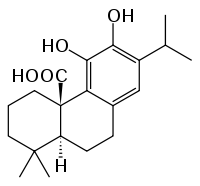Carnosic acid
 | |
| Names | |
|---|---|
| IUPAC name
(4aR,10aS)-5,6-Dihydroxy-1,1-dimethyl-7-propan-2-yl-2,3,4,9,10,10a-hexahydrophenanthrene-4a-carboxylic acid | |
| Other names
Salvin | |
| Identifiers | |
| 3D model (JSmol) |
|
| ChEBI | |
| ChemSpider | |
| ECHA InfoCard | 100.110.784 |
| PubChem CID |
|
| UNII | |
| |
| |
| Properties | |
| C20H28O4 | |
| Molar mass | 332.44 g·mol−1 |
| Melting point | 185 to 190 °C (365 to 374 °F; 458 to 463 K) |
| Except where otherwise noted, data are given for materials in their standard state (at 25 °C [77 °F], 100 kPa). | |
| | |
| Infobox references | |
Carnosic acid is a natural benzenediol abietane diterpene found in rosemary (Rosmarinus officinalis) and common sage (Salvia officinalis).[1] Dried leaves of rosemary or sage contain 1.5 to 2.5% carnosic acid.
Carnosic acid is used as a preservative or antioxidant in food and nonfood products (e.g. toothpaste, mouthwash and chewing gum -in which it has an antimicrobial effect on the microbes responsible for bad breath- or skin care products).
References
- ↑ Schwarz, Karin; Ternes, Waldemar (1992). "Antioxidative constituents of Rosmarinus officinalis and Salvia officinalis". Zeitschrift für Lebensmittel-Untersuchung und -Forschung. 195: 99–103. doi:10.1007/BF01201766.
This article is issued from
Wikipedia.
The text is licensed under Creative Commons - Attribution - Sharealike.
Additional terms may apply for the media files.